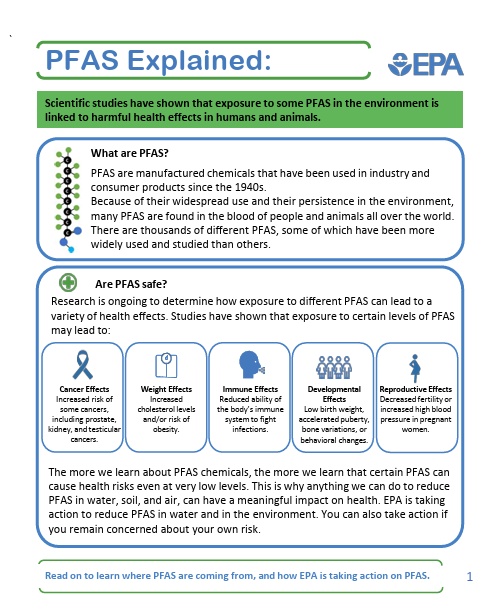PFAS: The Forever Chemicals
Investigating the hidden toxins that impact our health and environment.
I wrote this song about the PFAS crisis. Listen to "Something Icky In The Water" to hear a testimony set to music.
What Are PFAS?
PFAS (per- and polyfluoroalkyl substances) are a large group of man-made chemicals that have been used in industry and consumer products since the 1940s. They are known as "forever chemicals" because their carbon-fluorine bond is one of the strongest in chemistry, making them extremely resistant to breaking down in the environment or in our bodies. This durability gives them properties like resistance to grease, oil, water, and heat.
Where Are They Found?
Because of their widespread use and persistence, many PFAS are found in the blood of people and animals all over the world. They are passed from mother to child through the placenta and breast milk. Key sources of contamination include:
- Drinking Water: Contamination is a major concern, especially near military bases, airfields, and industrial sites that used PFAS-containing firefighting foams (AFFF).
- Food: Food can become contaminated through PFAS-containing packaging, or from being grown in contaminated soil or water. PFAS can also bioaccumulate in fish.
- Consumer Products: They are found in non-stick cookware, stain and water-repellent fabrics, carpets, cleaning products, and some cosmetics.
A Web of Health Impacts
The EPA and numerous scientific studies have shown that exposure to certain levels of PFAS is linked to a wide range of serious health effects. The connections are not isolated—they form a complex web of interrelated conditions affecting families across generations.
- Reproductive & Developmental Issues: Increased risk of preeclampsia in pregnant women, decreased fertility, and developmental delays in children, including impacts on cognitive, language, and motor skills.
- Increased Cancer Risk: Links to an increased risk of several cancers, including kidney, testicular, prostate, and digestive system cancers like colorectal cancer.
- Metabolic Disorders: Associations with an increased risk of obesity, high cholesterol, and type 2 diabetes.
- Immune System Damage: Reduced ability of the body's immune system to fight infections and respond to vaccines.
- Hormone Interference: Disruption of the body's natural endocrine functions.
A Personal Testimony: The Willow Grove Legacy
A Family's Fight
My family's story is a direct reflection of the EPA's data. My father-in-law, exposed at Willow Grove, has service-linked colorectal cancer. My wife, who also spent time on the base, suffered from severe preeclampsia. Our daughter, from that same high-risk pregnancy, is autistic. This is not a coincidence; it is a clear pattern of multi-generational harm directly linked to a specific site of contamination.
The Amputee's Insight: A Theory on the Mechanism
My own health battles have led me to a hypothesis. As a long-term user of NSAIDs and Tylenol for pain, I've suppressed my body's natural inflammatory response. I believe this lack of inflammation—the body's primary defense and signaling system—may prevent it from properly identifying and fighting off the damage caused by toxins like PFAS, potentially allowing related health issues to develop unchecked.
What Is Being Done?
The EPA is taking action to address PFAS contamination through a strategic roadmap. This includes efforts to restrict PFAS from entering the environment, hold polluters accountable, and invest in research. In April 2024, the EPA announced the first-ever national, legally enforceable drinking water standard for certain PFAS, which will require public water systems to monitor for these chemicals and take action if levels are too high. Additionally, a potential treatment has been identified: a clinical trial found that cholestyramine, a cholesterol drug, can substantially decrease PFAS levels in the body.
Our Mission
Understanding the impact of environmental toxins like PFAS is central to the mission of Ability Forge. Our health stories do not happen in a vacuum. They are deeply connected to the environment we live in and the systemic failures that allow these "forever chemicals" to persist. Here, we connect the dots between data and lived experience, advocating for a world where our health is no longer compromised by hidden variables.
✨ Ask the Forge Investigator
Have a specific question about PFAS and its health effects? Our AI research assistant can help you find the answers.

